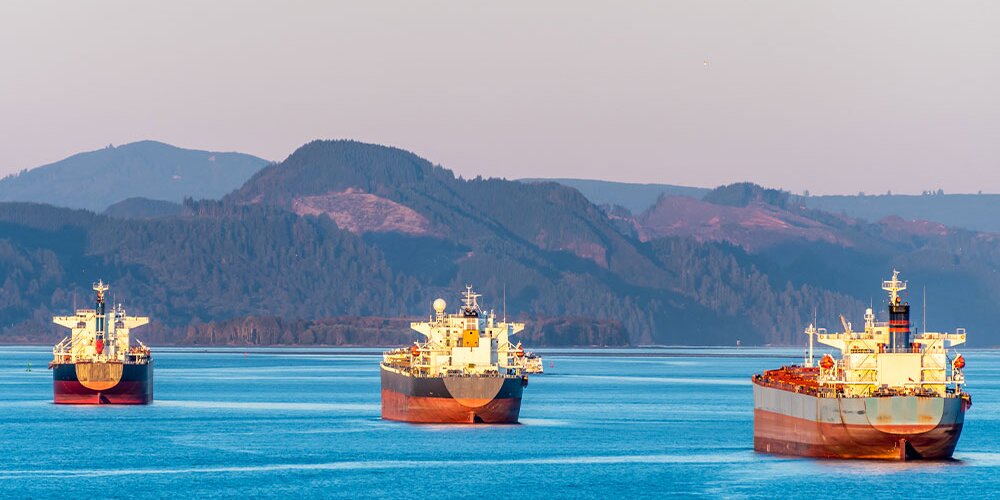Browse our services
Explore how Brookes Bell can help you
Find an expert
Meet our team, find and expert and connect
Contact us
Get in touch, we're here to help

In recent years, vessel operators have increasingly turned their focus toward environmental sustainability given the increasing intensity of targets and regulations that are driving industry-wide decarbonisation efforts. One of the strategies that is being employed in a bid to improve the energy efficiency of vessels is slow steaming: a practice involving operating vessels at significantly lower speeds to reduce fuel consumption and carbon emissions.
While slow steaming offers several advantages, it also presents challenges that must be carefully navigated, as it is not as straight forward as it may first seem. Providing his expert insight, Kieran Dodworth, Director of Naval Architecture at Brookes Bell, highlighted the benefits and complexities of this increasingly common practice.
Understanding Slow Steaming
Slow steaming refers to the deliberate reduction of a vessel’s speed, sometimes by up to 50%, which can result in lower fuel consumption and, consequently, reduced greenhouse gas emissions. The motivations behind slow steaming are cost savings and environmental compliance, particularly with regulations such as the Energy Efficiency Existing Ship Index (EEXI). As Kieran explains, “There’s a trend towards lower powered vessels to comply with the EEDI (Energy Efficient Design Index) during construction and reducing engine power for existing ships to comply with EEXI.”
The most obvious benefit of slow steaming is its environmental impact. By reducing speed, ships consume less fuel, leading to lower carbon dioxide emissions, as well as potential decreases in nitrous oxide. This reduction aligns with global efforts to combat climate change and adhere to stricter environmental regulations. From an economic perspective, fuel savings can be substantial, given that fuel costs represent a significant portion of a vessel’s overall operating expenses.
Kieran, however, points out that while the theoretical benefits are clear, practical implementation can be more complex. “Slow steaming results in lower emissions, but there needs to be a holistic approach to whether it is the right choice industry wide."
One of the primary challenges associated with slow steaming is the potential impact on fleet dynamics and ship performance. Reducing the average speed of the global fleet means that a greater number of vessels and increased cargo capacity will be required to carry the same amount of cargo, which could, paradoxically, offset the environmental benefits that slow-steaming originally envisaged.
“If your world fleet slows down, you need more ships to carry the same amount of cargo around,” Kieran notes. “This increase in fleet size entails additional emissions from the construction and operation of more vessels, which themselves are deeply carbon intensive projects, even just in the pure production of the quantity of steel needed. For example, the closures of the Suez Canal due to armed conflict was accompanied by temporary increases in the size of the world fleet.
If we are looking at slow steaming as a solution for industry-wide decarbonisation, we need to understand that it is not always practical in every scenario and shouldn’t be relied upon as a primary solution,” Kieran added.
Furthermore, slow steaming can affect a ship's ability to navigate through adverse weather conditions. Lower powered ships may struggle against strong winds and heavy seas, potentially leading to increased fuel consumption and extended voyage times. “If you have low power, then you can have trouble punching against heavy weather resulting in longer voyage times and higher consumption of fuel,” Kieran explains. This limitation necessitates a reconsideration of propulsion systems to ensure vessels can maintain operational efficiency under varying conditions – for example a rethink on propeller design and the LRM (Light Running Margin).
“It is worth noting that slow steaming might not be giving the energy saving levels that one might expect if all of your thinking is done in flat water – the longstanding naval architecture approach to ship powering,” he cautions. “The real-world performance of vessels often deviates from flat-water assumptions, underscoring the need for comprehensive data and analysis in real terms.”
Future Directions
Addressing the challenges of slow steaming requires innovative solutions and adaptive strategies. Alternative propulsion methods, such as wind propulsion and rotor sails, could complement slow steaming practices. As Kieran advocates, “rather than make wind the enemy, make it the friend,” emphasising the potential of these technologies to enhance fuel efficiency and environmental performance.
While slow steaming offers significant environmental and economic benefits, it is not a total fix to the industry’s decarbonisation challenges. The complexities it introduces necessitate a nuanced approach, considering factors such as fleet size, weather conditions, and real-world performance data.